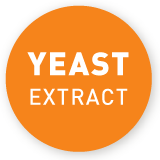Analysis of glutamate content of packet soups
In media reports, the food ingredient yeast extract is often merely reduced to the amino acid glutamate, which is a natural protein building block contained in yeast. However, scientific analysis shows that yeast extract not only contains glutamate, but micronutrients and the entire spectrum of protein building blocks as well. Together, these constituents account for the inherent spicy taste of yeast extract. The glutamate content of yeast extract is generally around five per cent. This is low compared with other commonplace foodstuffs.
In tomatoes, peas and mushrooms, for example, the glutamate content is significantly higher than in yeast extract. One tomato contains approximately twice the amount of glutamate present in 200 ml of yeast extract flavoured bouillon. In numerous foodstuffs and dishes – such as goulash or spaghetti bolognese – natural glutamate accounts for the popular intensive taste. According to Western German Münster University of Applied Sciences (Fachhochschule Münster), a portion of beef goulash contains 135 mg of glutamate, and the corresponding figure for a portion of spaghetti bolognese served with parmesan cheese is as high as 1,500 to 2,000 mg.
In particular, ready meals such as packet soups and bouillons are seen as being “glutamate bombs”, as they generally contain yeast extract or monosodium glutamate (MSG). This is a fallacy, as shown by the research conducted at Münster University of Applied Sciences under the direction of Prof. Dr. Ursula Bordewick-Dell. Her analysis of standard packet soups (beef, chicken, tomato and vegetable) revealed that those seasoned with yeast extract contained the lowest amounts of glutamate. By way of example, beef and chicken soups seasoned with MSG contained more than 600 mg of glutamate per 250 ml. The corresponding figure for comparable soups seasoned with yeast extract, on the other hand, was less than 30 mg per 250 ml. The soup containing the most glutamate was a tomato soup seasoned with MSG (1.060 mg per 250 ml, compared with 270 mg per 250 ml in soup with yeast extract). However, this high glutamate content is not solely due to MSG, but above all to the ingredient tomatoes or tomato powder. Tomatoes contain naturally high amounts of glutamate.
A direct comparison of vegetable soups proved particularly revealing. The packet soup seasoned with yeast extract contained even less glutamate than a home-made vegetable soup (0.06 mg per 250 ml compared with 0.005 mg per 250 ml in the soup made with yeast extract). This shows that it is not yeast extract that is responsible for the glutamate content of foods, but first and foremost the foods themselves, the reason being that many natural foodstuffs – such as the vegetables in home-made soup – have a naturally high glutamate content. In the home-made soup, the higher glutamate content is again mainly due to tomatoes.
These analyses show that yeast extract is far more than just glutamate and by no means responsible for foods containing high amounts of glutamate. Yeast extract is classed as a seasoning owing to the fact that it consists of amino acids, vitamins and minerals from the yeast cell.



